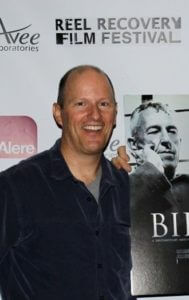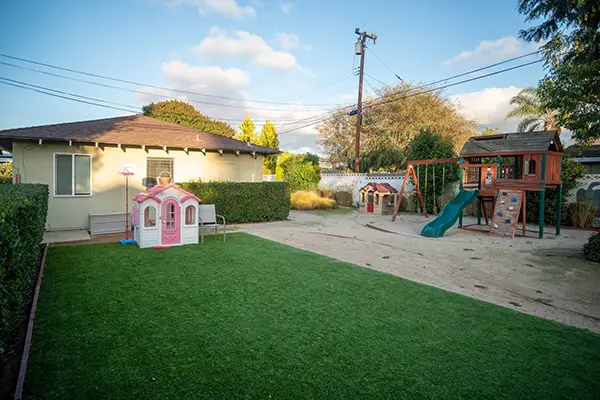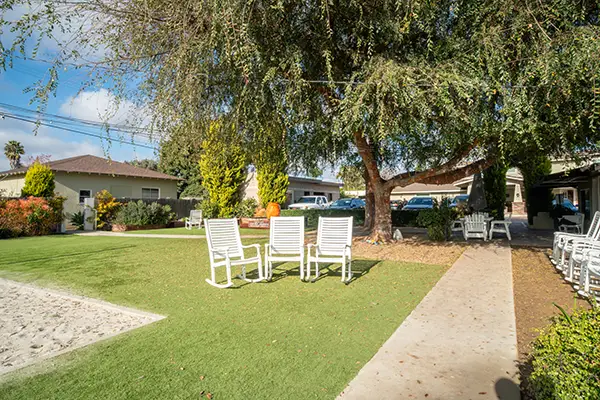 In 2016, Neil Scott, the producer and host of RECOVERY – Coast to Coast visited our beautiful campus and interviewed some of our team members along with care partners and alumnae. His radio show is a two hour nightly national radio talk show dealing exclusively with addiction, with a focus on recovery. In addition, he has been a keynote speaker at numerous national, state and local events and has lectured at America’s leading schools of alcohol and drug studies, including Rutgers University. We are grateful we had the opportunity to get to know him and share all the wonderful life-changing work that we are doing at New Directions for Women. In this segment, he is interviewing, Dan Carracino, President & Chair Board of our Foundation at New Directions.
In 2016, Neil Scott, the producer and host of RECOVERY – Coast to Coast visited our beautiful campus and interviewed some of our team members along with care partners and alumnae. His radio show is a two hour nightly national radio talk show dealing exclusively with addiction, with a focus on recovery. In addition, he has been a keynote speaker at numerous national, state and local events and has lectured at America’s leading schools of alcohol and drug studies, including Rutgers University. We are grateful we had the opportunity to get to know him and share all the wonderful life-changing work that we are doing at New Directions for Women. In this segment, he is interviewing, Dan Carracino, President & Chair Board of our Foundation at New Directions.
Neil Scott:
Joining us in this segment is Dan Carracino. Dan’s a board member. He is a pretty amazing guy. You may recognize the name. He was involved in a major project producing a documentary on Bill Wilson. Bill W. came out I believe it was in the spring of 2012. Dan was one of the directors of that film. Dan, welcome to Recovery Coast to Coast. Thank you for what you’ve done with that film.
Dan Carracino:
Thank you very much for having me on the air, Neil. I really appreciate it.
Neil Scott:
Brief background on the film. It was a labor of love for you for many, many years in putting this together. If you have not seen it, how can people find it?
Dan Carracino:
They can find it on Amazon or you can get it on iTunes or on Amazon instant video. We have a website page124.com. There is a page on there where you can find where it is. We’re really excited. Over the last year we’ve been reediting the film to get it onto PBS. We just learned last week that it will be broadcast in October in Southern California and then just picked up by other stations during that same month. So, we’re really excited about it.
What we’re really happy about is that when we were editing the film the very last thing that we had to remove from the film because we couldn’t get it to work was a section on Al- Anon. As you know, Al-Anon is very important to recovery. A lot of people actually get into recovery themselves by going through Al-Anon. For the people who are non-familiar with Al-Anon, Al-Anon is for the members in the families and the friends of people who are suffering from addiction. It’s not necessarily for people suffering from addiction directly themselves. They suffer from it indirectly.
We always wanted to include it in the film but when we were testing audiences you just know when you’ve lost the audience. Every time we cut it, no matter what we did, we would just see the audience check out. What happened subsequent to the film – the film was released in 2012, so it’s been several years – we found an audio recording of Lois Wilson from 1952. It’s the earliest recording by far that we have of her where she speaks very beautifully about Al-Anon and her involvement in it. It’s only one year old at that point. So, she has a much younger voice and much more youthful voice. I think we were able to get it this time. So, we’re very excited to include that.
Neil Scott:
Even if you have seen the film before, there is added footage coming up.
Dan Carracino:
Yeah. We had to add about 15 minutes to the film. It was very interesting. The running time on the film just turned out to be right in the middle between the two times that PBS was giving us. So, the question was – and they were saying to us you’ll probably reach a larger audience if you can make this shorter. We tried to make it shorter but what happened was every time we removed something we realized if we remove that then nobody is going to know what we’re talking about five minutes from now. We ended up adding 15 minutes. What it allowed us to do was remove a narrator that we had gone to as a technique towards the very end to shorten the film for the theatrical release. By removing that we were actually able to get Bill Wilson to tell more of the story. We were able to include some more things that we hadn’t included before.
Neil Scott:
It’s a great film and photographs that you found. There’s a whole story behind that. We don’t have time to get into today. But I’d like to have you back on the radio show to talk about the making of Bill W., if we can do that. We can do that by phone at some point.
Dan Carracino:
I’d be very happy to do that. Thank you for your interest.
Neil Scott:
Dan Carracino joining us tonight. Again, we are down here at New Directions for Women. Dan, how long have you been on the board and what brought you here to do this service work?
Dan Carracino:
I have a family member who suffers from addiction, who is now in recovery. She invited me to a lunch at New Directions. I would think it was 18 years ago now. So, we donated some money. It was being run by a different executive director than the current executive director here, a good person, a slightly different vision. She had to move on and then they brought in another person.
A friend of mine cornered me in a grocery store one day. I have a background in business. I had run a business for about 15 years. She said to me – I mean she literally cornered me in the grocery store and she said you have to get on the board for New Directions because they need somebody with some business sense. They have very good people there, a lot of lawyers, and they need somebody with some business sense. So, I got on the board here about 12 years ago. One of the first things we did was go out and recruited the current Executive Director Beck Flood.
Neil: She was in New Jersey at the time.
Dan Carracino:
Yeah. She was in New Jersey at Seabrook House. I think she was there for over 20 years. She and her husband, I remember having a meeting with them at dinner. I said to them, listen, I have to tell you very frankly that a startup would probably be easier than what I’m asking you to walk into here. The care was still good here. It was just that there were certain things that had occurred. It was just over time. Becky came here. We just recently completed a renovation on the main building. I really believe it’s the most beautiful recovery place for women in the country. It’s just a beautiful, beautiful place and personal.
Neil: What makes it so successful, Dan?
Dan Carracino:
It’s that personal thing. All the women here know what the mission is. It is about transforming women’s lives one day at a time. I’ll tell you one really amazing story. They tailor the treatment to the specific case.
Neil: It’s not Kentucky fried treatment.
Dan Carracino:
No. I’ve never heard that term before but no it’s not. There was a woman who had been in a number of treatment facilities. This was a number of years ago. I think the situation has gotten even more difficult for people who are not familiar. If you have a loved one who is suffering from addiction, you want to get them into recovery. If you’re watching late night television, it’s like bring them here. We promise recovery. Anybody who knows anything about recovery, it’s like no. That’s not how it works.
This woman had been to a number of places. Whether it was good fortune or bad fortune, her family had money. They were putting her in these places where they would pay a lot of money. She wouldn’t last four days. These places would keep the money. They would just keep putting her in place after place. She got here. The team here recognized that what she needed was a sobriety coach. She needed somebody with her 24 hours a day to get her through that initial period. Where she’d only been able to stay at places for a week at most, and I don’t think she ever stayed more than four days at a place, she was here for 90 days. I don’t know if she’s had continuous sobriety. I know she’s sober today. It’s one of those great stories. It’s tough.
Neil: When people go through treatment there is a misconception that you go through it for 30 days, 60 days, even 90 days and you’re well. No. That’s the beginning of a lifelong process of recovery that takes recovery management for the rest of your life, much like a diabetic and medical management of that disease. It’s not just going to treatment, get out of treatment, and you’re well. It’s an ongoing process. This is something that has impressed me about New Directions for Women in terms of their continuing care once they leave here and once they head out on that road to recovery.
Dan Carracino:
There really is a great network of women, an alumni association where they can continue to be in touch with each other, very much so. There’s some great AA in Southern California.
Neil: Back to your story about that person that went to a number of treatment centers and left very quickly. Then you said the word team here. A treatment center is not about how beautiful the facility is. It’s about the people who love the facility and work in the facility as a team. Show me a program that has long term staff that care, I’ll show you a successful treatment program like New Directions for Women. The staff here is really an excellent team.
Dan Carracino:
Neil, you’re hitting it. That’s exactly right.
Neil: Tell me about your experiences on the board. Has that been a good experience for you?
Dan Carracino:
It’s been a fantastic experience for me. I just went through a great training thing with a group called Alchemy on even making your board better. We have a very active board, a 17 member board. A lot of people are very active and bring different skillsets into it, business people, and people in recovery, and doctors. It’s a really great mix, young people and older people. Again, Becky did a great job of building that. We have two boards actually. We have a board that’s the operating board and then we have a board that’s a foundation board. It’s funny. I’m the chair of the foundation board, which is somewhat ironic because foundation boards are strictly about raising money.
When I was in business, my business partner put into the agreement, I was forbidden to be on the sales floor. It was like here comes a deal killer. I gave them advance warning. It’s all worked out okay. We’ve got some great people on the foundation board too. It’s funny. Having gone through the training, I don’t know that I would have two boards now. I think it’s the responsibility of boards, especially for a non-profit and New Directions is non-profit, you have to be about raising money. Every member has to be committed to that.
Neil: Give, get, or get off.
Dan Carracino:
It’s give and get. You know the terminology. I just learned that terminology myself. I knew the give part. The get part speaks to why I was forbidden from the sales floor.
Neil: Dan Carracino joining us on Recovery Coast to Coast. You’ve been on the board 18 years?
Dan Carracino:
No. I’ve been on the board for about 12 years. I’ve been involved here for about 18 years, just donating to it. Like I said, my friend Ruth cornered me in that store.
Neil: What’s the goal of the board going forward?
Dan Carracino:
We have a six year plan or a six phase plan. We’ve just completed our second phase of it to completely upgrade the campus. Upgrade is the wrong word. It’s to fulfill a new vision or an extended vision of it. The first thing we did is acquire two homes right in the neighborhood, beautiful homes, so that we could take the main building which houses 18 women and renovate that. We just finished that. So, we’re through the first two phases. Those are the two, as a board member, the ones that gave me the greatest angst, when you’re taking 18 beds offline. We got through it really, really well. We had another good year. A lot of women got healthy here. We were able to maintain the same level of care while we were undergoing it.
I said to a number of the women on staff here – when we were going through the building – I’m a little concerned that this is so nice that the women aren’t going to want to leave. The next phase of it, we want to build a large facility for the children. One of the things that New Directions for Women does that very few facilities do, I heard recently there’s one in Maine and us or at least there was one in Maine, we take women with young children.
One of the barriers to recovery for women is that they don’t want to leave their young children behind. A number of women, unfortunately, lose custody of their children. So, they’ll come here to get back the custody of the children. But the women who have their children want to be able to keep them. So, we want to build a facility – we have that now. One of the buildings on campus can house 6 women and I think 12 children. Our vision is to build a much larger building that can have daycare for up to 80 children so that even women, after they come through, can leave the children here. Women in the community can bring their children by and know that they’re in a safe environment.
We had our fundraiser and a woman spoke at the breakfast that we had. She was a child. It was really very interesting to hear a child’s point of view. Her mother was living in hotels. She was, are you okay, mom? Are you okay, mom? Are you okay, mom? So, it was really something.
Neil: It is truly an amazing program, New Directions for Women in Costa Mesa, California. Dan Carracino is a member of the board, an active member of a very active board. Dan, thank you for your time.
Dan Carracino:
Thank you very much for having me, Neil.



